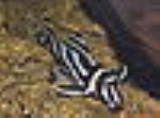
Zebra Pleco
Encyclopedia
Hypancistrus
zebra, gets its name from its black and white stripes, resembling the colouration of a zebra
. It is a species of catfish
endemic to the Big Bend area of the Xingu River
, a tributary of the Amazon River
, and was first described in the early 1990s. This fish was exported from Brazil
in great numbers for sale as aquarium fish. However, in 1998 the Brazilian government banned the export of all species of Hypancistrus, including H. zebra.
H. zebra is threatened by the construction of the Belo Monte Dam
in the Xingu river which will cause the drying out of the entire known distribution range of the species. It is subject to several captive breeding programs.
Mature males have a larger head and longer interopercular spine
s than females. After spawning, the males will guard the eggs. The fry swim after seven days and absorb the yolk sac in two weeks.
convention often applied to Loricariidae
. H. zebra is a predator, feeding on small invertebrates such as chironomid-larvae. It is nocturnal, moderately territorial, and prefer plenty of hiding places.
Hypancistrus
Hypancistrus is a genus of Loricariid catfish originating from the Amazon basin in South America. Unlike many of the other Loricariids, however, some Hypancistrus species are more carnivorous and enjoy meat in their diet...
zebra, gets its name from its black and white stripes, resembling the colouration of a zebra
Zebra
Zebras are several species of African equids united by their distinctive black and white stripes. Their stripes come in different patterns unique to each individual. They are generally social animals that live in small harems to large herds...
. It is a species of catfish
Catfish
Catfishes are a diverse group of ray-finned fish. Named for their prominent barbels, which resemble a cat's whiskers, catfish range in size and behavior from the heaviest and longest, the Mekong giant catfish from Southeast Asia and the second longest, the wels catfish of Eurasia, to detritivores...
endemic to the Big Bend area of the Xingu River
Xingu River
The Xingu River , also called Rio Xingu, is a 1,230-mile long, river in north Brazil; it is a southeast tributary of the Amazon River.-Description and history:...
, a tributary of the Amazon River
Amazon River
The Amazon of South America is the second longest river in the world and by far the largest by waterflow with an average discharge greater than the next seven largest rivers combined...
, and was first described in the early 1990s. This fish was exported from Brazil
Brazil
Brazil , officially the Federative Republic of Brazil , is the largest country in South America. It is the world's fifth largest country, both by geographical area and by population with over 192 million people...
in great numbers for sale as aquarium fish. However, in 1998 the Brazilian government banned the export of all species of Hypancistrus, including H. zebra.
H. zebra is threatened by the construction of the Belo Monte Dam
Belo Monte Dam
The Belo Monte Dam is a proposed hydroelectric dam complex on the Xingu River in the state of Pará, Brazil...
in the Xingu river which will cause the drying out of the entire known distribution range of the species. It is subject to several captive breeding programs.
Mature males have a larger head and longer interopercular spine
Odontode
Odontodes, or dermal teeth, are hard structures found on the external surfaces of animals or near internal openings. They comprise a soft pulp surrounded by dentine and covered by a mineralized substance such as enamel, a structure similar to that of teeth. They generally do not have the same...
s than females. After spawning, the males will guard the eggs. The fry swim after seven days and absorb the yolk sac in two weeks.
In the aquarium
Hypancistrus zebra is called L046,L098,L173 in terms of the L-numberingL-number
The L-number system is a semi-scientific classification system of catfish based on photographs of shipments of tropical catfish of the family Loricariidae published by the aquarium magazine DATZ ....
convention often applied to Loricariidae
Loricariidae
Loricariidae is the largest family of catfish , with almost 700 species and new species being described each year. Loricariids originate from fresh water habitats of Costa Rica, Panama, and tropical and subtropical South America. These fish are noted for the bony plates covering their bodies and...
. H. zebra is a predator, feeding on small invertebrates such as chironomid-larvae. It is nocturnal, moderately territorial, and prefer plenty of hiding places.

